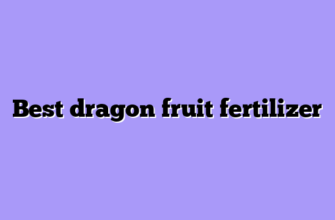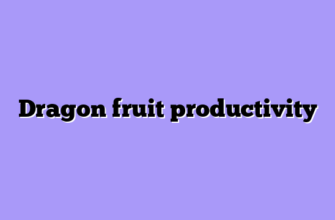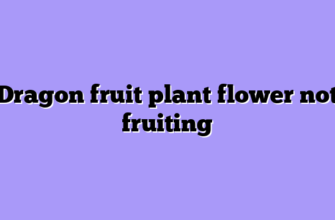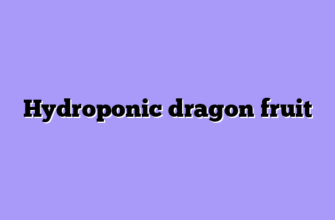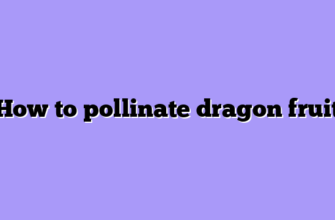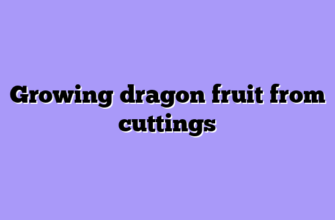Dragon fruit fungicide is a type of fungicide used to protect dragon fruit plants from fungal diseases. Dragon fruit is a tropical fruit that is native to Central and South America and is now grown in many parts of the world. Fungal diseases can cause significant damage to dragon fruit plants, reducing yields and even killing the plants.
Dragon fruit fungicides are designed to protect the plants from these diseases, allowing them to produce healthy, high-quality fruit. This article will discuss the different types of dragon fruit fungicides available, their benefits, and how to use them effectively.
Battling the Blight: A Dragon Fruit Fungicide Guide from a Farmer’s Perspective
As a dragon fruit farmer, I’ve seen my fair share of fungal foes. These nasty microscopic invaders can wreak havoc on my precious fruit, leaving behind unsightly blemishes and reducing yields. But I’ve also learned a thing or two about keeping them at bay. So, if you’re a fellow dragon fruit enthusiast facing fungal threats, here’s a step-by-step guide on how I fight back using fungicides:
Step 1: Identify the Culprit
Not all fungicides are created equal. Before you head to the store, it’s crucial to identify the specific fungal disease plaguing your dragon fruit. Common culprits include anthracnose, canker, and phomopsis. Examining the affected areas and consulting agricultural resources can help you pinpoint the problem. If you’re unsure, don’t hesitate to seek guidance from your local agricultural extension service.
Step 2: Choose Your Weapon
Once you’ve identified the enemy, it’s time to select the appropriate fungicide. Different fungicides target specific fungal groups. Look for ones labeled to target your specific disease. Common fungicides used for dragon fruit include copper fungicides, azoxystrobin, and propiconazole. Always refer to the label for application rates and instructions specific to your chosen product.
Step 3: Prepare for Battle
Safety first! Before you start mixing, ensure you have the proper protective gear. This includes gloves, eye protection, and long sleeves. Read the fungicide label thoroughly and measure the required amount accurately. Most fungicides require dilution in water. I typically use a backpack sprayer for even application.
Step 4: Apply with Precision
Timing is key! Apply the fungicide according to the label’s instructions. For most fungicides, preventative application is more effective than waiting for an outbreak. Focus on targeting all surfaces of the plant, including the stems, fruits, and undersides of the leaves. Thorough coverage is crucial to reach all potential fungal spores.
Step 5: Repeat and Monitor
Fungal diseases are persistent, so a single application might not be enough. The label will recommend a repeat application schedule, which you should strictly follow. In between applications, monitor your plants closely for any signs of fungal resurgence. Early detection is key to preventing a full-blown outbreak.
Remember:
- Always follow the label instructions for application rates and safety precautions.
- Rotate fungicides periodically to prevent resistance build-up in fungal populations.
- Practice good sanitation measures in your dragon fruit orchard. This includes removing plant debris and fallen fruits, which can harbor fungal spores.
By following these steps and being proactive, you can keep your dragon fruit healthy and fungal-free, ensuring a bountiful harvest. Remember, a healthy crop is a happy farmer!
How to Use Dragon Fruit Fungicide to Protect Your Plants
Dragon fruit fungicide is an effective and natural way to protect your plants from fungal diseases. It is made from the extract of the dragon fruit, which is a tropical fruit native to Central and South America. The extract contains a variety of compounds that are known to have antifungal properties.
When using dragon fruit fungicide, it is important to follow the instructions on the label carefully. Start by mixing the fungicide with water according to the directions. Then, spray the mixture onto the affected plants, making sure to cover all of the leaves and stems. Allow the fungicide to dry completely before watering the plants.

Dragon fruit fungicide can be used as a preventative measure or to treat existing fungal diseases. If you are using it as a preventative measure, it is best to apply it every two weeks. If you are using it to treat an existing fungal disease, it is best to apply it every three days until the disease is gone.
Dragon fruit fungicide is an effective and natural way to protect your plants from fungal diseases. When used properly, it can help keep your plants healthy and free from disease.
The Benefits of Using Dragon Fruit Fungicide in Your Garden
Dragon fruit fungicide is an effective and natural way to protect your garden from fungal diseases. Fungal diseases can cause significant damage to plants, leading to wilting, discoloration, and even death. Dragon fruit fungicide is a safe and effective way to protect your garden from these diseases.
Dragon fruit fungicide is made from the extract of the dragon fruit plant, which is native to Central and South America. The extract contains a variety of compounds that are effective at controlling fungal diseases. These compounds include flavonoids, terpenoids, and phenolic acids. These compounds work together to inhibit the growth of fungal spores, preventing them from causing damage to your plants.
Dragon fruit fungicide is easy to use and can be applied directly to the leaves of your plants. It is also safe to use around children and pets, as it is non-toxic and does not contain any harsh chemicals. Additionally, dragon fruit fungicide is effective at controlling a wide range of fungal diseases, including powdery mildew, black spot, and rust.
Using dragon fruit fungicide in your garden can help to protect your plants from fungal diseases. It is easy to use, safe, and effective at controlling a wide range of fungal diseases. By using dragon fruit fungicide, you can help to ensure that your garden remains healthy and vibrant.
Understanding the Different Types of Dragon Fruit Fungicides
Dragon fruit, also known as pitaya, is a tropical fruit that is native to Central and South America. It is a popular crop in many parts of the world, including Southeast Asia, Mexico, and the Caribbean. Unfortunately, dragon fruit is susceptible to a variety of fungal diseases, which can cause significant damage to the crop. To protect dragon fruit from fungal diseases, growers must use fungicides.
Fungicides are chemical compounds that are used to control or prevent the growth of fungi. There are several different types of fungicides available for use on dragon fruit, each with its own unique properties and benefits. Understanding the different types of fungicides can help growers make informed decisions about which products to use on their crops.
- The first type of fungicide used on dragon fruit is contact fungicides. These fungicides are applied directly to the plant and are effective against a wide range of fungal diseases. Contact fungicides are typically used as a preventative measure, as they are not effective against established fungal infections.
- The second type of fungicide used on dragon fruit is systemic fungicides. These fungicides are absorbed by the plant and move throughout its tissues, providing protection against fungal diseases. Systemic fungicides are typically used to treat established fungal infections, as they are more effective than contact fungicides.
- The third type of fungicide used on dragon fruit is protective fungicides. These fungicides form a protective barrier on the plant, preventing fungal spores from entering and causing infection. Protective fungicides are typically used as a preventative measure, as they are not effective against established fungal infections.
- Finally, the fourth type of fungicide used on dragon fruit is curative fungicides. These fungicides are applied directly to the plant and are effective against established fungal infections. Curative fungicides are typically used to treat established fungal infections, as they are more effective than contact and protective fungicides.
By understanding the different types of fungicides available for use on dragon fruit, growers can make informed decisions about which products to use on their crops. Each type of fungicide has its own unique properties and benefits, so it is important to choose the right product for the job. With the right fungicide, growers can protect their dragon fruit crops from fungal diseases and ensure a successful harvest.
The Pros and Cons of Using Dragon Fruit Fungicide
Dragon fruit fungicide is a natural, organic product that is used to protect plants from fungal diseases. It is made from the extract of the dragon fruit plant, which is native to Central and South America. This product has become increasingly popular in recent years due to its effectiveness and its natural, organic ingredients. However, there are both pros and cons to using dragon fruit fungicide.
Pros
One of the main advantages of using dragon fruit fungicide is that it is an organic, natural product. This means that it is safe for use around children and pets, and it does not contain any harsh chemicals or toxins. Additionally, dragon fruit fungicide is effective at controlling a wide range of fungal diseases, including powdery mildew, black spot, and rust. It is also easy to apply and can be used on a variety of plants, including vegetables, fruits, and ornamentals.
Cons
One of the drawbacks of using dragon fruit fungicide is that it is not as effective as some synthetic fungicides. Additionally, it can be expensive, and it may need to be applied more frequently than other products. Additionally, dragon fruit fungicide can be difficult to find in some areas, and it may not be available in all stores.
Overall, dragon fruit fungicide is a natural, organic product that can be used to protect plants from fungal diseases. It is safe for use around children and pets, and it is effective at controlling a wide range of fungal diseases. However, it is not as effective as some synthetic fungicides, and it can be expensive and difficult to find in some areas.
Tips for Applying Dragon Fruit Fungicide to Your Plants
- Read and follow all instructions on the label of the fungicide before applying it to your plants.
- Make sure to wear protective clothing, such as long sleeves, pants, and gloves, when applying the fungicide.
- Mix the fungicide with water according to the instructions on the label.
- Apply the fungicide to the leaves and stems of the dragon fruit plants using a spray bottle or a garden sprayer.
- Make sure to cover the entire plant, including the undersides of the leaves, with the fungicide solution.
- Reapply the fungicide every 7-10 days, or as directed on the label, to ensure that the plants are adequately protected.
- Wash your hands thoroughly after applying the fungicide.
- Dispose of any unused fungicide according to the instructions on the label.
Conclusion
In conclusion, dragon fruit fungicide is an effective and safe way to protect dragon fruit plants from fungal diseases. It is easy to use and can be applied to the plants in a variety of ways. Dragon fruit fungicide can help to reduce the spread of fungal diseases and keep dragon fruit plants healthy and productive.

